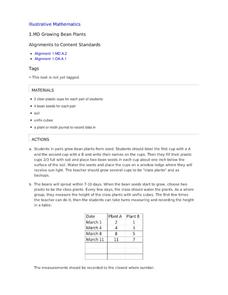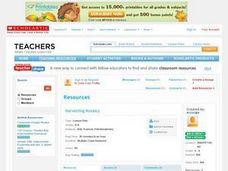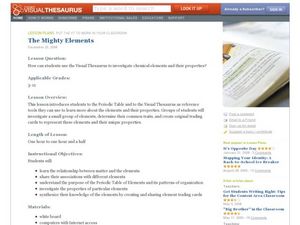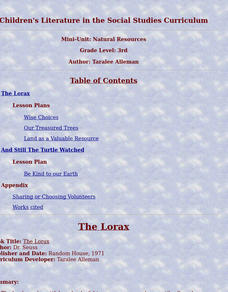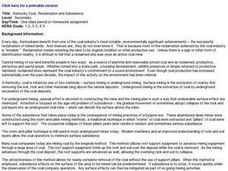MENSA Education & Research Foundation
Hurricanes
Learn the ins and outs of hurricanes through a series of lessons answering, "What is a hurricane? How does it travel? How is one formed, measured, and named?" Information is presented through informative text and images, while...
Illustrative Mathematics
Growing Bean Plants
Plant growth experiments offer rich, cross-curricular learning opportunities that can really excite and engage young learners. For this series, children work in pairs planting, measuring, and comparing the height of bean plants in order...
Curated OER
Harvesting Mosaics
Students use pieces of farm pictures to investigate the elements of art. In this farm art lesson, students use pieces of pictures to create an original artwork. Students use the Internet to find images. Students create a...
Curated OER
Time Line Reporters
Individuals in your class research the origin of an animal and present their discoveries to the class. The first appearance of the animal and its date of extinction are indicated on a class time line.
Curated OER
The Mighty Elements: Using the Visual Thesaurus to Investigate Chemical Elements
Pupils create trading cards for elements in the Periodic Table. Initially, they are introduced to the Periodic Table of Elements and the concept of elements in the world around us. After dividing into groups, learners use the Visual...
Curated OER
Aquatic Exotics
Students identify and describe the aquatic exotic species found in Illinois. Using the internet, they research the species origins and discover their effects on native species in the area. They discuss how appropriate it is to introduce...
Curated OER
Fossils
For this earth science worksheet, students use the clues given at the bottom of the sheet to solve the crossword puzzle on fossils. They identify specific names of fossils and how to make a mold of one.
Curated OER
Weather and Water in Ghana
Students research the rainy and dry season to investigate Africa's weather. In this African weather lesson, students use the given websites to research the rainy and dry seasons of Ghana in Africa. Students then read stories about life...
Curated OER
Where Do Animals Come From?
Students use library search engines to research an animal and its origin. In this animal research activity, students research their assigned animal using ProQuest. Students then find the country of origin of the animal using a library...
Curated OER
Serial Dilutions Made Easy
Students improve their skills and comprehend the particular application for which serial dilutions are a tool. Serial dilutions are often used in microbiology, biotechnology, and in chemistry classes, to name just a few.
Curated OER
Element Scavenger Hunt
For this elements, worksheet, learners use the periodical table to determine the origin of the element names such as elements named after countries, people, colors and towns. This worksheet has 71 fill in the blank questions and 1 short...
Curated OER
Thinking About Life in Geological Time Scales
Students create a large (classroom-sized) timeline showing the history of life on Earth for the last 5 billion years. They are able to identify the events that are relevant to their taxonomic projects (the Origins and important...
Curated OER
Bolts Out of the Blue
Students research different types of lightning patterns and compare their origins to an experiment on static electricity. They research different types of lightning, and explain how different light patterns result from those charges.
Curated OER
Genetics 5 Technology
Students, after studying extraction and gel electrophoresis, recombinant DNA, transgenic organisms, and reproductive cloning, summarize the main concepts in DNA technology. They analyze the applications of DNA: forensics, medicine,...
Curated OER
Carrot Sticks or French Fries?
Students investigate the influence of fast food brand names on food choices and analyze the factors that contribute to branding preferences. They write an opinion essay on the corporate responsibility to influence food choices.
Curated OER
Land as a Valuable Resource
Young scholars investigate why the soil is important to our lives. For this natural resources lesson, students have a farmer as a guest speaker. Young scholars begin to understand how farmers use and protect our natural resource....
Curated OER
Clothesline Sleuth
Third graders discover the origin of an item of clothing. In this clothing lesson, 3rd graders navigate the net to locate information related to various fabrics. Students answer questions and define vocabulary about...
Curated OER
Salmon Homing Instincts
Young scholars role-play salmon returning to original streams using their sense of smell like the salmon do. They smell cinnamon, vanilla and peppermint on cards and follow that scent to locations in the classroom that represent their...
Curated OER
Ocean Water
For this ocean water worksheet, students will look at how oceans affect us, how oceans originated, and what oceans are made up of. This worksheet has 15 fill in the blank questions.
Curated OER
Where Should It Go? Recycle? Compost? Incinerate? Landfill?
Students discuss what happens to trash after it is collected. They sort "clean" trash into groups depending on whether it should be recycled, incinerated, placed in a landfill, composted or if it is something we could avoid using.
Curated OER
Kentucky Coal, Reclamation and Subsidence
Middle schoolers read and discuss the information that they read on the "Kentucky Coal, Reclamation and Subsidence." They then answer questions in reference to the reading. Some questions that students answer are: What is...
Curated OER
The History of Life
In this Earth's history activity, learners will complete 5 true or false questions based on the early history of the Earth. Students will match 7 fossil vocabulary words to their definitions. Learners will complete 4 short answer...
Curated OER
Fossil Evidence
Students evaluate each other's fossil imprints and they try to identify the original object. They comprehend the importance of accuracy in identifying a fossil imprint. Students create an answer sheet that has space for the names of the...
Curated OER
Organization of the Elements and Periodic Table
Pupils identify how to relate the position of an element in the periodic table to its atomic number and atomic mass. They also identify and interpret how to use the periodic table to identify metals, semimetals, nonmetals, and halogens....

